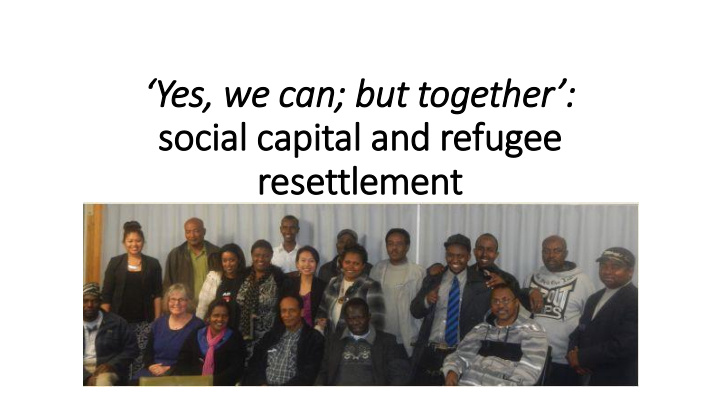



‘Yes, we can; but together’: social capital and refugee resettlement
A refugee is someone who: • "owing to a well-founded fear of being persecuted for reasons of race, religion, nationality, membership of a particular social group or political opinion, is outside the country of his nationality, and is unable to or, owing to such fear, is unwilling to avail himself of the protection of that country or return there because there is a fear of persecution ...“ UNHCR Convention, 1951
How many people are we talking about? • 750 refugees resettled each year under the Refugee Quota Programme • In the past 25 years, nearly 25,000 refugees from more than 50 countries have arrived in NZ under the Programme • Up to 300 people per year from refugee like situations through the Refugee Family Support Category • About asylum seekers a year, 50% of whom are found to be refugees. • Although the numbers are relatively small, refugees have greatly added to New Zealand’s ethnic diversity
A Conceptual Framework Defining Core Domains of Refugee Integration Ager and Strang (2008)
What’s needed for successful integration? • Resettled refugees need a network of relationships to ensure they can live meaningful lives in New Zealand. • These relationships are complex and exist between individuals and communities at local and national levels • The relationships cement concepts of citizenship and refugee rights — social, cultural and economic (e.g. employment, housing, education or health) and civil and political rights (e.g. language, security or residency/citizenship) (Elliott & Yusuf, 2014)
Social capital; what do we mean? • The relationships between people and their social networks and the associated norms of reciprocity and trustworthiness. • The invisible glue that holds society together . (Putman, 2007)
Social bonds • Links within the community • community organisations are key • Success determined by committed voluntary leaders • Important role for religious institutions
Social bridges • Links between refugee background people and others in the community; • Often facilitated through, neighbourly connections, education and employment • Brokered by leaders "Great to see that people have an open mind to know more about refugees. Once a refugee – we also have to reach out to those people and to others. We need to reach out to all communities" - ARCC Board member, Dr Elfadil
• ‘Give us an opportunity to participate and learn through our experience and participation…we need to not be told but to go through, to experience.’ - Yehuala from the WISE Collective
Linking • Links between people from a refugee background and government institutions • community leaders play important roles linking the community with public service providers, such as schools, child and family health services and Work and Income services (Searle et al, 2012)
Leaders central to integration and successful settlement UNHCR goals for resettlement and integration • “to support the development of strong, cohesive refugee communities and credible refugee leadership” UNHCR Resettlement Handbook, 2011 Research recommendations stress refugee communities and leaders must be involved in the decision making about the policies and programmes intended for refugees (Gruner & Searle, 2011; Mugadza, 2012; Tuwe, 2012).
“Many issues affect these communities, and then we asked Many refugee background ourselves again, can we help community leaders spend decades provide solutions to alleviate the involved in voluntary work. living conditions of our people? We answered , “YES WE CAN, BUT But how much do we invest in TOGETHER !”” leadership development and/or (ARCC Management Team, 2013) support?
References Ager A, Strang A (2008). Understanding integration: a conceptual framework. Journal of Refugee Studies 21: 166 – 191. ARCC Management Team (2013) Yes we can, but together: Auckland Refugee Community consultation repor t. Auckland, Auckland Refugee Community Coalition. Elliott, S., & Yusuf, I (2014) Yes we can, but together’ Social capital and refugee resettlement in Kōtuitui : New Zealand Journal of Social Sciences Online, 2014 Vol. 9, No. 2, 101 – 110, http://dx.doi.org/10.1080/1177083X.2014.951662 Gruner, A, & Searle, W. (2011). New Z ealand’s refugee sector: perspectives and developments, 1987– 2010. Quota refugees ten years on series. Wellington: department of labour . Mugadza, Vimbai. (2012). Empowerment based approaches to quota refugee resettlement in New Zealand. AUT University. Putman R (2007). E Pluribus Unum: diversity and community in the twenty-first century the 2006 Johan Skytte Prize Lecture. Scandinavian Political Studies. 30: 137 – 174. Searle, Wendy, Prouse, Emma, L’Ami , Emily, Gray, Alison, & Gruner, Anna. (2012). New Land, New Life: Long term settlement of refugees in New Zealand (main report). Quota Refugees Ten Years on. Department of Labour. Wellington. Tuwe, Kudakwashe. (2012). The challenges of health promotion within African communities in New Zealand. AUT University.
Recommend
More recommend